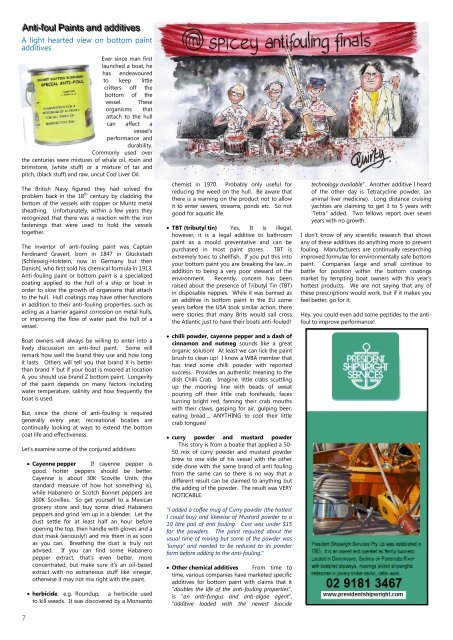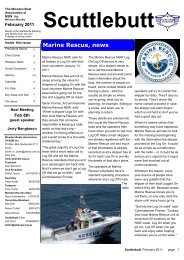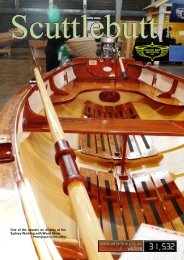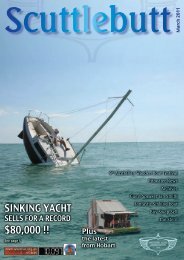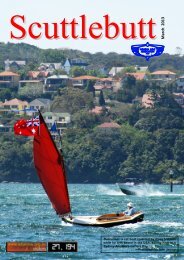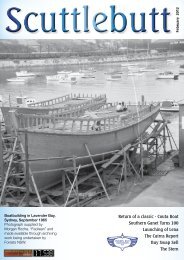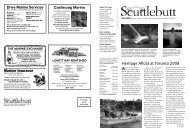April 2013 - Wooden Boat Association NSW
April 2013 - Wooden Boat Association NSW
April 2013 - Wooden Boat Association NSW
You also want an ePaper? Increase the reach of your titles
YUMPU automatically turns print PDFs into web optimized ePapers that Google loves.
Annt ti ii--f foouul ll Paai iinnt tss aanndd aaddddi iit ti iivveess<br />
A light hearted view on bottom paint<br />
additives<br />
Ever since man first<br />
launched a boat, he<br />
has endeavoured<br />
to keep little<br />
critters off the<br />
bottom of the<br />
vessel. These<br />
organisms that<br />
attach to the hull<br />
can affect a<br />
vessel's<br />
performance and<br />
durability.<br />
Commonly used over<br />
the centuries were mixtures of whale oil, rosin and<br />
brimstone, (white stuff) or a mixture of tar and<br />
pitch, (black stuff) and raw, uncut Cod Liver Oil.<br />
The British Navy figured they had solved the<br />
problem back in the 18 th century by cladding the<br />
bottom of the vessels with copper or Muntz metal<br />
sheathing. Unfortunately, within a few years they<br />
recognized that there was a reaction with the iron<br />
fastenings that were used to hold the vessels<br />
together.<br />
The inventor of anti-fouling paint was Captain<br />
Ferdinand Gravert, born in 1847 in Glückstadt<br />
(Schleswig-Holstein, now in Germany but then<br />
Danish), who first sold his chemical formula in 1913.<br />
Anti-fouling paint or bottom paint is a specialized<br />
coating applied to the hull of a ship or boat in<br />
order to slow the growth of organisms that attach<br />
to the hull. Hull coatings may have other functions<br />
in addition to their anti-fouling properties, such as<br />
acting as a barrier against corrosion on metal hulls,<br />
or improving the flow of water past the hull of a<br />
vessel.<br />
<strong>Boat</strong> owners will always be willing to enter into a<br />
lively discussion on anti-foul paint. Some will<br />
remark how well the brand they use and how long<br />
it lasts. Others will tell you that brand X is better<br />
than brand Y but if your boat is moored at location<br />
A, you should use brand Z bottom paint. Longevity<br />
of the paint depends on many factors including<br />
water temperature, salinity and how frequently the<br />
boat is used.<br />
But, since the chore of anti-fouling is required<br />
generally every year, recreational boaties are<br />
continually looking at ways to extend the bottom<br />
coat life and effectiveness.<br />
Let’s examine some of the conjured additives:<br />
7<br />
Cayenne pepper If cayenne pepper is<br />
good, hotter peppers should be better.<br />
Cayenne is about 30K Scoville Units (the<br />
standard measure of how hot something is),<br />
while Habanero or Scotch Bonnet peppers are<br />
300K Scovilles. So get yourself to a Mexican<br />
grocery store and buy some dried Habanero<br />
peppers and grind 'em up in a blender. Let the<br />
dust settle for at least half an hour before<br />
opening the top, then handle with gloves and a<br />
dust mask (seriously!) and mix them in as soon<br />
as you can. Breathing the dust is truly not<br />
advised. If you can find some Habanero<br />
pepper extract, that's even better, more<br />
concentrated, but make sure it's an oil-based<br />
extract with no extraneous stuff like vinegar,<br />
otherwise it may not mix right with the paint.<br />
herbicide, e.g. Roundup, a herbicide used<br />
to kill weeds. It was discovered by a Monsanto<br />
chemist in 1970. Probably only useful for<br />
reducing the weed on the hull. Be aware that<br />
there is a warning on the product not to allow<br />
it to enter sewers, streams, ponds etc. So not<br />
good for aquatic life.<br />
TBT (tributyl tin) Yes, It is illegal,<br />
however, it is a legal additive to bathroom<br />
paint as a mould preventative and can be<br />
purchased in most paint stores. TBT is<br />
extremely toxic to shellfish. If you put this into<br />
your bottom paint you are breaking the law...in<br />
addition to being a very poor steward of the<br />
environment. Recently, concern has been<br />
raised about the presence of Tributyl Tin (TBT)<br />
in disposable nappies. While it was banned as<br />
an additive in bottom paint in the EU some<br />
years before the USA took similar action, there<br />
were stories that many Brits would sail cross<br />
the Atlantic just to have their boats anti-fouled!<br />
chilli powder, cayenne pepper and a dash of<br />
cinnamon and nutmeg sounds like a great<br />
organic solution! At least we can lick the paint<br />
brush to clean up! I know a WBA member that<br />
has tried some chilli powder with reported<br />
success. Provides an authentic meaning to the<br />
dish Chilli Crab. Imagine, little crabs scuttling<br />
up the mooring line with beads of sweat<br />
pouring off their little crab foreheads, faces<br />
turning bright red, fanning their crab mouths<br />
with their claws, gasping for air, gulping beer,<br />
eating bread.... ANYTHING to cool their little<br />
crab tongues!<br />
curry powder and mustard powder<br />
This story is from a boatie that applied a 50-<br />
50 mix of curry powder and mustard powder<br />
brew to one side of his vessel with the other<br />
side done with the same brand of anti fouling<br />
from the same can so there is no way that a<br />
different result can be claimed to anything but<br />
the adding of the powder. The result was VERY<br />
NOTICABLE.<br />
“I added a coffee mug of Curry powder (the hottest<br />
I could buy) and likewise of Mustard powder to a<br />
10 litre pail of anti fouling. Cost was under $15<br />
for the powders. The paint required about the<br />
usual time of mixing but some of the powder was<br />
'lumpy' and needed to be reduced to its powder<br />
form before adding to the anti-fouling.”<br />
Other chemical additives From time to<br />
time, various companies have marketed specific<br />
additives for bottom paint with claims that it<br />
“doubles the life of the anti-fouling properties”,<br />
is “an anti-fungus and anti-algae agent”,<br />
“additive loaded with the newest biocide<br />
technology available”. Another additive I heard<br />
of the other day is Tetracycline powder, (an<br />
animal liver medicine). Long distance cruising<br />
yachties are claiming to get 3 to 5 years with<br />
'Tetra" added. Two fellows report over seven<br />
years with no growth.<br />
I don’t know of any scientific research that shows<br />
any of these additives do anything more to prevent<br />
fouling. Manufacturers are continually researching<br />
improved formulae for environmentally safe bottom<br />
paint. Companies large and small continue to<br />
battle for position within the bottom coatings<br />
market by tempting boat owners with this year’s<br />
hottest products. We are not saying that any of<br />
these prescriptions would work, but if it makes you<br />
feel better, go for it.<br />
Hey, you could even add some peptides to the antifoul<br />
to improve performance!


